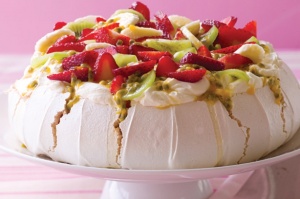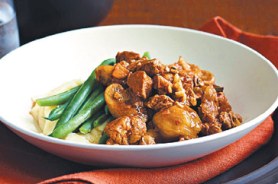Yum-yum Pavlova! Happy 100th and 26th!
 So today is a special day in that it’s my 26th Birthday and I can’t begin to describe how excited I am! It’s also (believe it or not) my 100th post on the site, so today’s post for me is doubly special! I’m so proud to have made it this far and I know I’m gonna keep working hard to get more stuff out to you all. So with today being a special day I thought I’ be a bit naughty and give you all a very delicious desert recipe! I’ve always been fond of Pavlova and have spared no thought to whether or not the diet would suffer when one was on offer to me. Today we’re going simple and just making a nice pav, with a fruit salad and whipped cream topping so there isn’t a lot of difficulty to this meal.
So today is a special day in that it’s my 26th Birthday and I can’t begin to describe how excited I am! It’s also (believe it or not) my 100th post on the site, so today’s post for me is doubly special! I’m so proud to have made it this far and I know I’m gonna keep working hard to get more stuff out to you all. So with today being a special day I thought I’ be a bit naughty and give you all a very delicious desert recipe! I’ve always been fond of Pavlova and have spared no thought to whether or not the diet would suffer when one was on offer to me. Today we’re going simple and just making a nice pav, with a fruit salad and whipped cream topping so there isn’t a lot of difficulty to this meal.
Nutritional Information
(Do you really want to know?)
Prep Time
20 Minutes
Cooking Time
1 Hour and 15 Minutes
Ingredients
- 6 Egg Whites, at room temperature
- Pinch of Salt
- 1 1/2 Cups (330g) Caster Sugar
- 3 tsp Cornflour
- 1 tsp White Vinegar
- 1 tsp Vanilla Essence
- 300ml Thickened Cream
- Seasonal fresh fruit, to serve (in the image it’s Kiwi Fruit, Passion Fruit, and Strawberries)
Utensils Needed
- Baking Tray
- Non-stick Baking Paper
- Electric Beater/Mixer
- Large Bowl
Method
- Preheat your oven to 150°C. Line the baking tray with the non-stick baking paper. Draw a 20cm circle on the paper, place on the tray, circle side down.
- Use the electric mixer to whisk the egg whites and salt until soft peaks form. Add sugar, 1/2 cup at a time, whisking for 1 minute after each addition. Once all the sugar has been added, continue to whisk on high for 3 minutes.
- Combine your cornflour, vinegar and vanilla essence. Add to meringue and whisk until just combined.
- Use a spatula to spread meringue over the circle, smoothing the surface and sides. Reduce the oven temperature to 120°C. Bake for 1 hour to 1 hour 15 minutes – the pavlova should be dry to the touch. Turn off the oven and leave to cool completely.
- Whip cream until thick. Spoon onto your pavlova and decorate with fresh fruit of your choice. Cut into wedges, serve and make sure to enjoy!
Be Creative – Simply put the pavlova’s taste will change depending on what you add to it so be creative in your toppings, try a tropical mix or a mixed berry assortment with a berry glaze made from scratch. Really the reason I love pav so is because it can be made a hundred different ways, you’ve just gotta get inspired.
Notes – Now when making meringue it is empirical you do not leave even a little yolk in the mix, doing so will stop the egg whites from peaking and you’ll be there forever just scratching your head and wondering what went wrong. Also when you place your eggs into your bowl make sure it is clean and that it’s as dry as a bone, otherwise once again you’ll have trouble getting your egg whites to peak.











